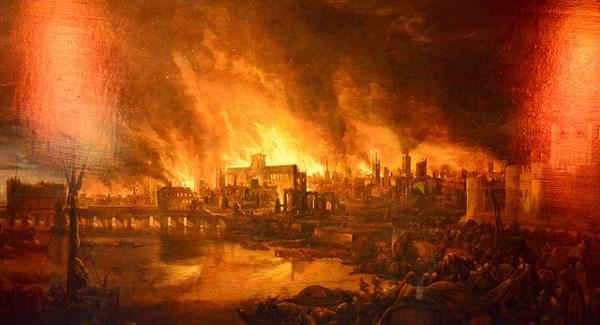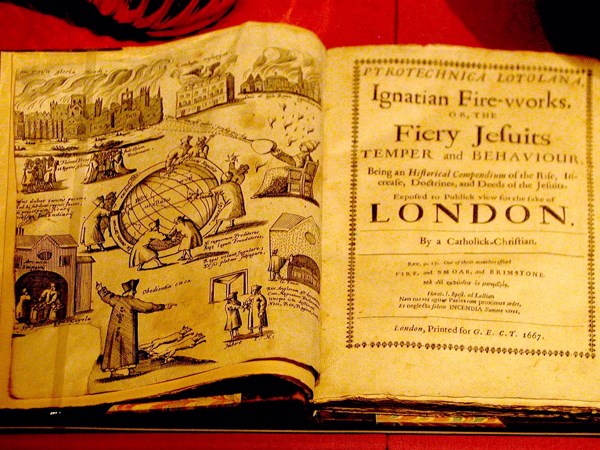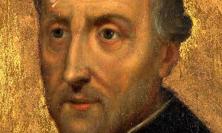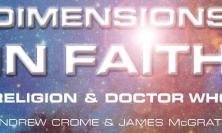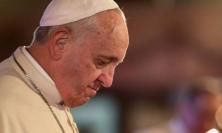Viewers of ITV’s The Great Fire, which concludes this week, will have seen the unfolding of a conspiracy theory in which the finger of blame for the Great Fire of London is pointed directly at Catholics. This is not pure dramatisation – there was no shortage of anti-Catholic sentiment in 17th century England, not least because of the events of 5 November 1605. Historian Thomas M. McCoog SJ surveys the religious and political landscape in which Catholics – and particularly Jesuits – became the prime suspects for the Great Fire of London.
What could they have discussed? Unfortunately our knowledge of the conversation between the English Jesuit Edward Courtney (vere Leedes) and King Charles II consists solely of a few comments in a letter. Courtney, the English province’s procurator in Antwerp but soon to be provincial, had met with Charles as the king prepared for his return to England in May 1660. The Jesuit superior general, Goswin Nickel, wrote to Courtney afterwards to say that he hoped that the procurator’s raised expectations would not be frustrated.[i]
One may surmise that the conversation addressed Charles’s desire to improve or eliminate the penal conditions of English Catholics. Approximately a month before the meeting, Charles had issued the so-called ‘Declaration of Breda,’ in which he promised that ‘no man shall be disquieted or called in question for differences of opinion in the matter of religion which do not disturb the peace of the kingdom.’ Catholics surely would be included in this. ‘Scarcely ever in the memory of the Fathers [the Jesuits],’ the provincial Richard Barton (vere Bradshaigh) effused on 2/12 May 1660, ‘did a more joyful day for this city [London] and island dawn than the 8th of May last, on which day Charles Stuart, in solemn form, with the most magnificent pomp and incredible applause, was proclaimed King of England, Scotland, France, and Ireland, and Defender of the Faith. Never at any other time was there shown such great attachment and veneration for a King.’[ii] Such enthusiasm could not even be dampened by the revival of the detested Jacobean oath of allegiance, with its offensive clauses:
that the pope neither of himself nor by any authority of Church or See of Rome, or by any other means with any other, has any power to depose the king &c., or to authorize any foreign prince to invade him &c., or to give licence to any to bear arms, raise tumults . . . . And I do further swear that I do from my heart abhor, detest, and abjure, as impious and heretical this damnable doctrine and position, – that princes which be excommunicated by the pope may be deposed or murdered by their subjects or by any other whatsoever. And I do believe that the pope has no power to absolve me from this oath.[iii]
This unforeseen development the English Jesuits blamed not on the king, whose Catholic sympathies were viewed with suspicion by Anglican clergymen, but on residual English anti-Catholicism.
As the Commonwealth waned and the possibility of a restored monarchy waxed, many distanced themselves from the events of the preceding two decades and their involvement therein by accusing Roman Catholics of the crimes. Richard Baxter, a non-conformist minister who associated with the Parliamentary armies but later played a role in the restoration of the monarchy, dedicated a treatise to Protector Richard Cromwell, in which he exonerated non-conformists of any blame for the execution of King Charles I, the Civil War and subsequent developments. That unhappy state of affairs he attributed to Papist infiltration. Hiding behind various theological masks, the Papists, he contended, successfully fostered discontent and discord among the Protestants. No one but a Roman Catholic would execute a king: such an act ‘was utterly against the mind and thoughts of Protestants.’ Baxter advanced ‘undenyable Arguments that it was the work of Papists, Libertines, Vanists, and Anabaptists’[iv]; true Protestants, in fact, suffered because of their opposition to regicide. In a later and more restrained analysis of Roman Catholicism, Baxter reminded readers how a ‘peaceable spirit,’ a mark of the true Church, was absent in the Catholic Church, where instead were found ‘turbulent spirits . . . such as are made of Gunpowder, and speak fire and sword’.[v]
Of a similar mind was William Prynne, a Presbyterian lawyer and polemicist who supported the Restoration after his disenchantment with the Commonwealth. He republished an earlier English translation of a work by the Dominican philosopher Tommaso Campanella, in which the friar had advised Spanish rulers in the 1590s to sow division and discontent in England, Scotland, Ireland and Holland if they wished to conquer these countries. [vi] Catholic policy ever since has followed the principle that a kingdom divided against itself cannot stand. ‘Whether this be not the true and principal cause of all our sad divisions and wars both in Church and State,’ Prynne wrote in his preface, ‘let the reader resolve when he hath perused Campanella’.[vii]
The promises of tolerance made at Breda applied to non-conformists desperately blaming Roman Catholics and exonerating themselves for the turmoil, and to Roman Catholics anxiously demonstrating their devoted royalism. But translation of royal promises into practical religious tolerance depended on Charles’s first Parliament, the so-called ‘Cavalier’ Parliament, which convened on 8 May 1661. Instead of the religious toleration so desired by the king, Parliament passed a series of acts known collectively as the ‘Clarendon Code’ for the restoration and protection of the Anglican Church. These laws, directed principally against Protestant non-conformists for their role in the civil conflict, reinforced Catholic marginalisation. During Parliament’s first session, before the numerous episcopal vacancies had been filled, Roman Catholic gentry and nobility petitioned the House of Lords for relief from the penal laws. They argued that Catholics suffered grievously for their allegiance to the monarchy – although they conveniently overlooked Catholic and papal attempts to reach a modus vivendi with Oliver Cromwell – and that such loyalty made clear that non-conforming Protestants were the real enemy, the true threat, and not Catholics.
Some secular clergy under the guidance of John Sergeant (and his fellow members of the ‘Old Chapter,’ an influential vestige of Bishop Richard Smith’s episcopacy after his departure for France in 1631 that was neither recognised nor repudiated by the papacy) replied to Protestant non-conformist defamation of Catholics, by deflecting their accusations of treason and disloyalty from Catholics in general to Jesuits in particular. Consequently they proposed terms for toleration that included the expulsion of the Jesuits. Understandably the Jesuits argued for their inclusion in any tolerance because they too had suffered during the Interregnum, as did their students and their penitents.
Portrait of John Sergeant (from The Lisbon Collection, Ushaw College)
Martin Grene, who had earlier been assigned the unenviable task of translating and editing a refutation of Blaise Pascal’s Provincial Letters,[viii] wrote the first English apologia for the Society of Jesus. He vindicated Jesuits of traditional accusations regarding wealth, regicide and disloyalty, and explicated the popular image of a mythic Jesuit:
It is a strange thing to see what Character is commonly given the Jesuits. Every Jesuit, say our Pamphlets and Pulpits too, hath a Pope in his belly, a Macchiavel in his head, Mercuries wings on his feet, and the Mysterious feather of Lucian's cocks tail in his hand. . . . And if you ask, why Jesuits are never discovered . . . it is because the Jesuits have Proteus’s bodies.[ix]
The defence’s influence was minimal.
A committee of the House of Lords discussed possible Catholic relief in the summer of 1661, but failed to introduce any legislation before Parliament adjourned at the end of July. The bishops returned to the reconvened Parliament in November, and attempts to revive the discussion failed. Instead, the following spring, Parliament passed the second act of the Clarendon Code: the Act of Uniformity[x] made use of the new, revised Book of Common Prayer compulsory. Six months later, on 26 December 1662, Charles II’s first declaration of indulgence suspended the enforcement of the Act of Uniformity, and granted toleration. However, the king failed in subsequent attempts to entice Parliament to legislate in favour of tolerance. By March 1663, Charles retreated and rescinded his declaration. Catholics now hoped not for toleration but for the non-enforcement of the penal laws.
The expulsion of the Jesuits was still dangled as a carrot. The anonymous author of The Jesuite and priest discovered, or, A Brief discourse of the policies of the Church of Rome (London, 1663), insisted that a Jesuit (unnamed) encouraged antagonism between King Charles and Parliament, provoked a declaration of war, stirred up the ‘Sons of Belial to stain their Hands with his [Charles’s] Sacred Blood,’ exhorted the people to erect a Commonwealth, and then worked for its destruction (p. 11). All in a day’s work!
Protestant self-exonerating denunciations of Roman Catholics stirred up a fear of popery that persisted in Parliament and throughout England. Non-conformist ministers reminded the reading public that Catholics were the true enemies. Peter Du Moulin, an Anglican clergyman and son of the Huguenot Pierre Du Moulin, exculpated Protestants in general from the charge of regicide, and repudiated Catholic protestations of their loyalty during the rebellion.[xi] Du Moulin recalled the various plots and conspiracies hatched by Catholics against English monarchs, and highlighted conflicts between Jesuits and various princes. Did any Protestant divine ever engage in such activities? Presumably the answer is ‘no.’ But Du Moulin would not condemn all Catholics because of the antics of a few. Thus he proposed an oath of allegiance similar to the Jacobean oath that would separate the loyal sheep from the treacherous goats.
The Great Fire of London swept through the City from Pudding Lane to Pye Corner between 2 and 5 September 1666. The search for scapegoats rounded up the usual suspects. The popular English imagination associated Catholics with fire, from the Smithfield flames of Queen Mary Tudor to the gunpowder of Guy Fawkes. By the end of the year a royal proclamation ordered the banishment of all Roman Catholic priests, and the disarming of all Catholics who refused to take the oaths of supremacy and allegiance. Suspicion of Catholic involvement in the fire persisted and their guilt was later proclaimed in the inscriptions around the base of the Monument, despite the absence of any judgement, in any of the investigations, regarding their responsibility. More specifically, the finger was pointed at the Jesuits. An unnamed ‘Catholick-Christian’ surveyed in considerable detail the inflammatory speech and behaviour of the followers of Ignatius Loyola, whose first name he derived from ignis, Latin for fire. The Pyrotechnica Loyolana, Ignatian fire-works, or, The fiery Jesuits temper and behaviour being an historical compendium of the rise, increase, doctrines, and deeds of the Jesuits (London, 1667) highlighted in capital letters variations on ‘incendiaries’, ‘gunpowder’, ‘fire brands’, ‘fire’, ‘flames’ and ‘burnt’ in his exposition of Jesuit mastery of the art of making and directing fireballs.
The Pyrotechnica Loyolana - click here for high resolution.
Anti-Catholicism and anti-Jesuitism intensified in the 1670s as the political nation’s apprehension over the religious sentiments of the monarch increased. Charles’s marriage to the Portuguese Catherine of Braganza in 1662, his association with King Louis XIV of France – which had replaced Spain as the aggressive proponent of resurgent Catholicism – and his second, unsuccessful ‘Declaration of Indulgence’ in 1672, worried Parliament. But more worrisome was the religious affiliation of Charles’s brother and heir: James, Duke of York. The duke’s refusal to pronounce the oath required by the Test Act of 1673 – ‘I, N, do declare that I do believe that there is not any transubstantiation in the sacrament of the Lord’s Supper, or in the elements of the bread and wine, at or after the consecration thereof by any person whatsoever’ – proved what many long suspected: he was a Catholic. Attempts to exclude him from the throne involved proposals for a second marriage for Charles, ‘proof’ that the king had actually married one of his mistresses, and legitimation of one of his offspring. This ‘Exclusion Crisis’ warned English Protestants of what they could expect if a Catholic succeeded to the throne: a French absolute monarchy, a Roman inquisition, and Jesuit conspiracies. The disclosures of Titus Oates and Israel Tonge in 1678 conveniently proved everything that the Whigs, the supporters of exclusion, claimed. In the consequent hysteria, sixteen Jesuits and twenty-one non-Jesuits (including Archbishop Oliver Plunkett) were executed or died in prison. In 1681, the inscription on the Monument was amended through the addition of ‘But Popish frenzy, which wrought such horrors, is not yet quenched.’
However, the move to exclude James did not succeed. The Catholic Duke of York ascended the throne in 1685; and Charles was reconciled to the Roman Church on his deathbed: ‘Now is the winter of our discontent/Made glorious summer by this son of York.’ Summer ended when the Protestant winds of November 1688 propelled the fleet of William and Mary to Torbay.
Thomas M. McCoog SJ is provincial archivist emeritus and historian of the British province.
Find out more
Why were Jesuits hunted after the Gunpowder Plot? Visit the website of the Jesuits in Britain to read about the events leading up to and following 5 November 1605. Read >>
[i] General Nickel to Courtney (vere Leedes), Rome 3 July 1660, ARSI, Angl, 2/I, fol. 225r.
[ii] Richard Barton (vere Bradshaigh) to Nickel, (London?) 2/12 May 1660, published in Henry Foley SJ, Records of the English Province of the Society of Jesus, 7 vols. in 8 parts (Roehampton/London, 1875-1883), vol. 1, p. 231.
[iii] 3 James I, c. 4.
[iv] Richard Baxter, A key for Catholicks (London, 1659), p. 323.
[v] Richard Baxter, Catholick unity: or The only way to bring us all to be of one religion (London, 1660), p. 157.
[vi] De Monarchia Hispanica: Thomas Campanella an Italian friar and second Machiavel. His advice to the King of Spain for attaining the universal monarchy of the world (London, 1660).
[vii] Sig. (A 4v)
[viii] An Answer to the Provinciall Letters published by the Jansenists, under the name of Lewis Montalt against the Doctrine of the Jesuits and School-Divines (Paris, 1659).
[ix] Martin Grene, An Account of the Jesuites Life and Doctrine (n.p. [London], 1661), sig. A 3v- A 4r.
[x] 14 Car 2 c 4.
[xi] A vindication of the sincerity of the Protestant religion in the point of obedience to sovereignes opposed to the doctrine of rebellion authorised and practised by the Pope and the Jesuites (London, 1664).



